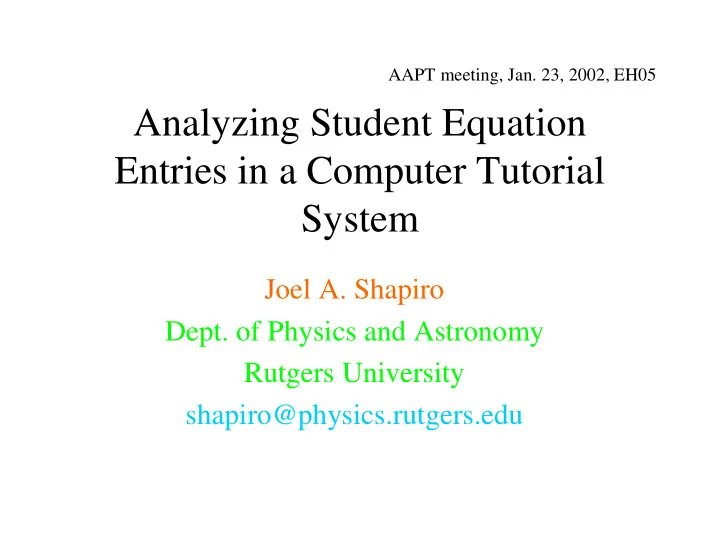

AAPT meeting, Jan. 23, 2002, EH05 Analyzing Student Equation Entries in a Computer Tutorial System Joel A. Shapiro Dept. of Physics and Astronomy Rutgers University shapiro@physics.rutgers.edu
Intelligent Tutoring Systems •Interactively helps students while they try to solve physics problems: •Not just a homework grader •Not just right or wrong •Models student understanding •Which parts of solving the problem does the student already know •What approach are they taking •Provides tutorial help when misconceptions observed. •Provides guidance when student doesn’t know how to proceed.
Andes II, an ITS for Intro Physics
Andes components • Problem solver: Generates methods of solution and ``canonical’’ equations • Algebra System: • Equation solver: solves systems of equations • Dependency checker • Equation checker • Workbench: provides interface for communicating with student • Help system: • Tracks student progress • Explores for possible corrections of wrong entries • Provides guidance for stuck students
Opening problem presentation
Andes in mid-solution
Equation for hanging body ab and Ftb represent the magnitudes of the acceleration and tension, so the student might reasonably write the equation:
Equations hard to identify See latex version
Make a list of all derived equations One way to do equation checking and derivation is to try to compile a list of all equations derivable from the canonical equations. •A student equation is correct if it is equivalent to one on the list •Each equation on the list has associated with it a list of sets of equations from which it can be derived. Presumably the student used one of these sets.
Problems with using a list •Need a set of manipulation rules which determine what gets derived. •If rules are too strong, too many, or infinitely many, equations will be derivable •If rules are too weak, reasonable correct equations will not be recognized •Andes I used this approach. In practice, it was found that only simple problems could be done this way – for more complex problems, the computer crashed before finishing the list.
Alternate method • The correctness of equations can be judged by whether or not they are true whenever the canonical equations are. [Called ``color by numbers’’] – This is easy to check, and is equivalent to algebraic derivability • Dependency on a subset can be ascertained if the equation is true whenever the subset is. – This is easy to check for linear equations, or for the linear expansion of the equations about the solution point.
Pros and cons of color by numbers Pro: powerful – works for all problems tried, and quickly, too. Cons: •Algebraic correctness is more inclusive than pedagogic correctness [slide to follow] •Independent equations can be dependent in the linear approximation about the solution point. •This can be fixed for the common and simple cases, but is a weakness in principle to the method.
Pedagogic vs. algebraic correctness See latex version, slide13
Pedagogic != algebraic See latex version, slide14
References on the Web • Algebra Subsystem for an Intelligent Tutoring System , Joel A. Shapiro, – http://physics.rutgers.edu/~shapiro/algsys.pdf – Submitted to International Journal of Artificial Intelligence in Education • Andes home page: http://www.pitt.edu/~vanlehn/andes.html • My email: shapiro@physics.rutgers.edu
Recommend
More recommend